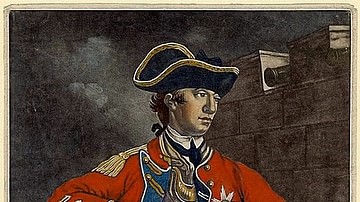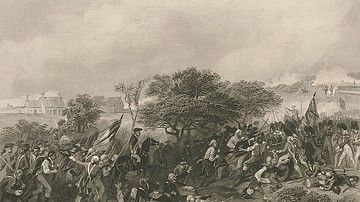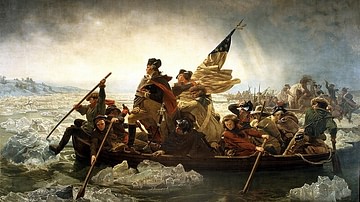The Battle of Brandywine (11 September 1777) was a major battle of the American Revolutionary War (1775-1783), fought between a British army under Sir William Howe and the American Continental Army led by General George Washington. The battle resulted in an American defeat and ultimately led to the British capture of Philadelphia.
Brandywine was the first major battle of General Howe's Philadelphia Campaign (24 July 1777 to 28 June 1778), which was launched with two main objectives: to capture the United States capital of Philadelphia and to force Washington into a decisive battle that he would likely lose. On 25 August 1777, the British army disembarked in Maryland and began the march to Philadelphia but found their path blocked by Washington's Continental Army, which was defending Brandywine Creek, in the modern township of Chadds Ford, Pennsylvania. While part of his army attacked the American center in a diversion, General Howe led the majority of his troops in a surprise attack against the American right flank. Although the Continental Army was ultimately forced to retreat, it held its ground for over eleven hours and was able to withdraw intact, preventing Howe from achieving his goal of destroying it. The British victory at Brandywine allowed Howe to capture Philadelphia on 26 September 1777. This would be a short-lived triumph, as the British would be forced to evacuate the city only nine months later.
Background
By the spring of 1777, the British and American armies had settled into a stalemate, warily eyeing one another, and anxiously waiting for someone to make the first move. For Sir William Howe, commander-in-chief of the British forces, it must have been a frustrating experience, as only a few short months earlier, victory had been within his grasp. He had beaten the Continental Army at the Battle of Long Island (27 August 1776), occupied New York City, and forced the Patriots out of Manhattan. He had then pursued the ragged and disease-ridden Continental Army through New Jersey, eventually forcing it over the Delaware River and into Pennsylvania. Howe's New York and New Jersey Campaign had then seemed successful; the British controlled much of southern New York and New Jersey, with the main American army teetering on the brink of disintegration. Back in London, Howe's name was lauded in the newspapers, and he was even awarded a knighthood by King George III of Great Britain (r. 1760-1820). It seemed that it would take only one more campaign season for the fledgling United States to fall, with Howe's name going down in history as the man who restored order to the British colonies.
However, Howe had underestimated the resolve of his opponent, General George Washington, the commander-in-chief of the Continental Army. Unlike many in Congress, Washington understood that the success of the entire American Revolution depended on the survival of his army; but with the enlistments of most of his troops set to expire in the new year, it did not seem that the army would survive for much longer. What he needed in order to convince his men to sign on again, and to inspire other Americans to enlist for the first time, was a victory – and he would soon get his chance. After chasing Washington out of New Jersey, Howe's army settled into winter quarters, little expecting that the Americans would have the daring or the strength to act. Washington therefore saw an opportunity to catch the enemy by surprise, and on the night of 25 December 1776, he led his army across the icy Delaware River to strike a Hessian garrison at the Battle of Trenton, taking 900 prisoners without the loss of a single American life. A week later, Washington secured another victory when he defeated British regulars at the Battle of Princeton. With these two victories, Washington wrested most of New Jersey away from British control and, most importantly, ensured that his army would survive for at least another year.
Now, with Howe sitting in his headquarters in New York City and Washington practically daring the British to attack his strong position at Morristown, New Jersey, an uneasy silence settled between the two armies, broken only by the sporadic but bloody skirmishing between American and British foraging parties. Howe realized that he would need to force Washington to fight a decisive battle in order to destroy him but knew he could not fight such a battle on Washington's terms; his plan, then, was to make a move on Philadelphia, the capital of the United States and the seat of the Second Continental Congress. Washington would certainly be pressured to not let the capital fall without a fight, which would force him off the high ground he possessed at Morristown to fight a decisive battle on ground of Howe's choosing. Furthermore, if Howe took Philadelphia, he would be in possession of the two largest, and most economically significant, cities in the Thirteen Colonies (the other being New York). Faced with the tantalizing prospect of both defeating Washington and seizing the American capital in a single campaign, Howe began making plans for his Philadelphia Campaign.
Howe Sets Sail
Throughout the remaining spring months of 1777, Washington and his officers watched the British movements with bemusement. British warships and transports had slowly begun to fill New York Harbor, leading Washington to believe Howe was about to make a move, but unsure where his destination would be. Could he be preparing to sail up the Hudson River and finish the British conquest of New York State? Could he be about to sail to Charleston to begin an invasion of the American South? All Washington could do was wait and see. He decided to move his army from Morristown to the high ground of Middlebrook, New Jersey, which would afford him a better look at the British movements.
Howe noticed Washington's move to Middlebrook and took it as a sign that the American general was growing antsy. On 13 July, hoping to further get into Washington's head – and maybe even force that decisive battle that he wanted so badly – Howe moved 18,000 troops into New Jersey and had them march toward the Delaware River as if they were advancing toward Philadelphia. Washington did not take the bait; his scouts had reported that the British had left too much baggage behind at their headquarters and could not possibly be marching toward Philadelphia. Washington remained atop Middlebrook Heights and watched as the British army continued marching back and forth, fifes and drums blaring. Then, on 24 July, the 18,000 redcoats filed onto the ships sitting in New York Harbor and sailed off into the Atlantic.
For the next several days, Washington stayed put, as he speculated with his generals and members of Congress where Howe was headed. In fact, as late as 21 August, the anxious Americans had no reliable intelligence as to the whereabouts of the British fleet, which seemed to have disappeared like a ghost. Then, on the 22nd, Washington received word that the British fleet had been spotted deep in Chesapeake Bay, and Howe's objectives finally became clear – he was launching an attack on Philadelphia. Assuming that the British meant to disembark at Head of Elk (on the Elk River) in Maryland, Washington immediately marched off in that direction. As a show of strength, Washington marched his 16,000 men through the streets of Philadelphia, where they were cheered by residents and members of Congress. The general himself rode alongside his staff, which had recently been joined by two young foreign officers who would soon become famous: both the Polish Casimir Pulaski and the French Gilbert du Motier, Marquis de Lafayette had joined the Continental Army over the summer, giving the Americans hope that the world was watching and supporting their cause.
Preparing for Battle
On 25 August, Howe began disembarking his army at Head of Elk, Maryland, exactly as Washington had predicted. He had decided to take this long, oversea voyage instead of the overland route since the overland path to Philadelphia had been too well-defended by Patriot forts. But Howe's men had paid dearly in pain and suffering during the harrowing, 34-day voyage to Maryland; the British and Hessian soldiers had been packed together in close quarters on the decks of these ships in scorching summer heat. Many became sick, and many died. Upon finally reaching shore, Howe rested his exhausted and seasick army at Head of Elk until the first week of September, when the redcoats finally set out in the direction of the US capital. By that point, Washington had managed to position his army in between Head of Elk and Philadelphia – if Howe wanted to take the city, he would have to fight for it.
The location that Washington chose to mount his defense was the countryside surrounding Brandywine Creek, consisting of wooded slopes and steep ravines, terrain in which the Americans excelled at fighting. The creek itself could only be crossed at fords, which Washington looked to defend. The primary point of crossing, Chadds Ford, became the center of the American line, defended by two of the army's most experienced divisions under generals Nathanael Greene and Anthony Wayne. Five miles to the south of Chadds Ford was the minor crossing of Pyle's Ford, which was guarded by General John Armstrong and 1,000 Pennsylvania militia; this was the leftmost point of the American line and was relatively well-anchored by rough terrain. The American right, which ran to the north of Chadds Ford, was defended by three divisions under the overall command of Major General John Sullivan. Unlike the left flank, the right wing had no natural obstacles to anchor it, except for a slope known as Birmingham Hill, which remained undefended itself. Furthermore, the Americans also neglected to defend the crossings at Trimble's Ford on the west branch of the Brandywine and Jeffries Ford on the east; the American right flank, therefore, was exposed and vulnerable.
Meanwhile, the British forces approached nearby Kennett Square, where they stopped to regroup; the British army had around 16,000 men, roughly the same number as the Americans. This part of Pennsylvania was replete with Loyalists, who helped Howe scout out Washington's positions; in this manner, Howe learned that the American right flank was their weak point. He therefore planned a flanking maneuver: 6,800 men under German General Wilhelm von Knyphausen would attack the American center at Chadds Creek as a diversion, while Lord Charles Cornwallis led 9,000 troops over Trimble's Ford and Jeffries Ford to attack the American right, thereby outflanking the Continental Army.
The Battle
The morning of 11 September 1777 opened with a strong white mist that covered the ground. At 5 a.m., Lord Cornwallis left the British camp with his column of 9,000 men and accompanied by General Howe himself. It was to be a treacherous 12-mile trek through narrow wooded passages, but Howe remained confident, as he had pulled off a similar flanking maneuver at the Battle of Long Island. The British were led through the thick woods by Loyalist guides, who had been sent by Joseph Galloway, a former member of the Continental Congress who had since become one of the most prominent Loyalists in Pennsylvania.
Around 10:30 a.m., General Knyphausen opened a thunderous artillery bombardment on the American center; this was done as much to signal to Howe that he was in position as it was to terrify the Continental troops. The Americans replied with cannon fire of their own, and for the next half hour, the woods around Brandywine Creek shook from the blasts of artillery. When Knyphausen failed to follow up his initial artillery bombardment with a ground assault, Washington began to suspect that he was being ambushed; around noon, these fears were realized when an American scout reported having seen a large British column moving along the Great Valley Road to the right of the American line. Realizing his flank was in danger, Washington sent two divisions under generals Adam Stephen and Lord Stirling to occupy Birmingham Hill, which sat on the creek's eastern side. Shortly afterward, Washington received intelligence from General Sullivan, assuring him that the earlier report had been wrong and that there were no signs of a British ambush after all. Likely breathing a sigh of relief, Washington ordered all units back to their initial positions and returned his focus back to Knyphausen.
At 2:30 p.m., meanwhile, Howe and Cornwallis had moved over both fords, arriving much earlier than anyone expected. Howe paused to rest his footsore troops, allowing them to be spotted by Patriot scouts, who reported back to Washington, telling him that the initial report had indeed been correct and that the British were poised to fall on the American right flank at any moment. In a panic, Washington ordered Stephen and Stirling back onto Birmingham Hill; but these divisions, disorientated by all the conflicting and contradictory orders, were slow to get back into position.
At 4 p.m., Howe gave the order to attack, and the redcoats streamed up Birmingham Hill with fixed bayonets. Stephen and Stirling managed to get their men in position in time to meet the British onslaught but, in their haste, neglected to plug the gap between their two divisions, creating an opening for the British to exploit. The British rushed through the gap and began enveloping the American right flank. Just as Stephen's and Stirling's men were at the point of breaking, they were reinforced by General Greene's brigade. Greene's troops had just run 4 miles (6 km) in 45 minutes to make it to the fight in time, but, exhausted as they were, their effort was enough to hold the line.
Birmingham Hill soon became the scene of bitter hand-to-hand fighting, as the orderly lines of soldiers soon disintegrated into masses of humanity, hacking at one another with bayonets and struggling for survival. Washington realized that the collapse of his right flank could very well result in the annihilation of the entire army and kept feeding troops into the bloodbath. Knyphausen, meanwhile, had kept his troops back until he heard the sound of battle upstream; now, confident that Howe and Cornwallis had begun their attack, he charged his own troops into the weakened American center. General Anthony Wayne, in charge of the defense of Chadds Ford, greeted the oncoming British and Hessians with rounds of grapeshot and devastating musket volleys so that the rushing water of the Brandywine became "much stained with blood" (Middlekauff, 395). Knyphausen's determined troops just kept coming, and Wayne was forced to retreat, leaving behind most of his cannons. Knyphausen captured these guns and turned them against the Americans.
On the right, the Americans were also on the point of retreating; after sustaining several British bayonet charges, they had been rolled off Birmingham Hill. Greene, Stephen, and Stirling managed to prevent a full rout, however, and rallied their troops; Marquis de Lafayette, who was helping to rally Stirling's division, was wounded in the leg. With the center having collapsed and the right flank barely hanging on, Washington decided it was time to begin a coordinated retreat. For nearly an hour, Greene, Stephen, and Stirling continued to hold back the British attack, winning precious time for the rest of the army to retreat toward Chester, a town on the Delaware River some 14 miles (22 km) away. Gradually, Stephen and Stirling also withdrew their troops, leaving Greene to hold the line alone until the onset of darkness, at which point he withdrew as well. Lafayette, despite his wound, played a major role in organizing and overseeing the retreat, while Polish General Pulaski commanded the rearguard that covered the army's escape.

Aftermath
When the sun rose on the morning of 12 September, the dead and wounded were counted. The British had lost 90 killed, 448 wounded, and 6 missing, while the Americans had suffered 200 killed, 500 wounded, and 400 captured – or around one-tenth of the Continental Army. It was a loss that Washington could ill afford. However, despite the defeat at Brandywine, Washington's army remained intact. What was more, he still stood in between Howe and the prize of Philadelphia.
Over the course of the next several days, Washington and Howe faced each other down, each general trying to outmaneuver his opponent. There were some minor actions; on the night of 20 September, for instance, the British launched a surprise attack on the encampment of Anthony Wayne's division, killing or wounding 200 Americans in what became known as the Paoli Massacre. But for the most part, there was little Washington could do without seriously risking the destruction of his army; he decided not to commit to another major battle in defense of Philadelphia. Realizing that Washington would not fight, Howe abandoned the half-hearted maneuvering and marched toward Philadelphia, entering the city on 26 September; the Second Continental Congress had already evacuated the city, having taken the city's bells (one of which became the famous Liberty Bell) with them.
The fall of Philadelphia was not as demoralizing as it would have been a year earlier; at the same time as the city fell, the Americans received word of victory at the Battles of Saratoga in New York State, which practically guaranteed France's entry into the war as an American ally. Washington would fight one more major battle with Howe at the Battle of Germantown (4 October 1777) before settling into winter quarters at Valley Forge, where he retrained his army. Despite winning at Brandywine and Germantown, the British discovered that they could not easily hold Philadelphia and abandoned the city in June 1778. Brandywine was, therefore, not a lasting victory for the British.











